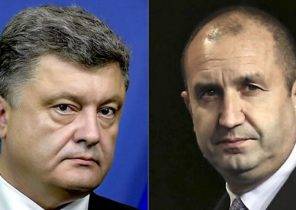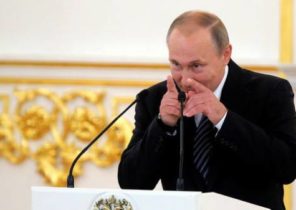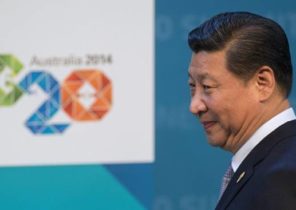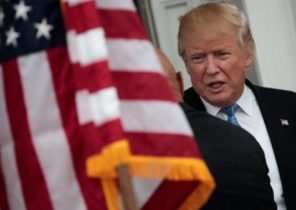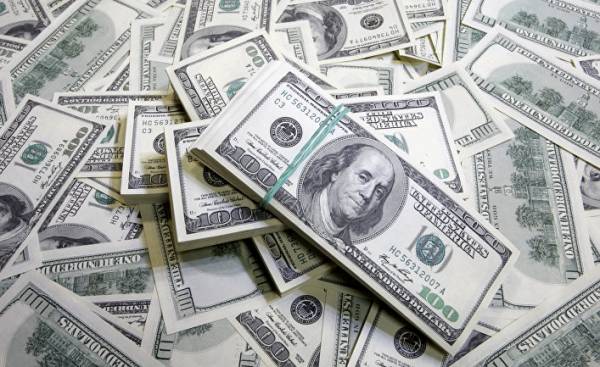
President trump last week’s statements about the dollar and monetary policy of the United States acknowledge that the strong dollar policy, which the Minister of Finance Robert Rubin (Robert Rubin) began in 1995, when the dollar was close to a record low for the post-war era level, will now change.
According to the President, a strong dollar “sounds good”, but the currency becomes “too strong”. “It is very difficult to compete when we have a strong dollar, while other countries devalue their currency,” he added. He also noted that he “likes the policy of low interest rates” and that Janet Yellen (Janet Yellen) may retain his post of the Chairman of the fed.
In addition, Mr. trump has abandoned his campaign promise to declare China a currency manipulator. He hinted that the U.S. was willing to make concessions in trade policy exchange for a strategic bargain with XI Jinping on North Korea.
Yesterday, the U.S. Treasury published its semi-annual formal report on the currency policies of America’s trading partners. It warned a number of countries, including China, South Korea, Taiwan, Germany, Switzerland and Japan, that they “are in control”, but concrete action against them are postponed — most likely indefinitely. Apparently, the administration decided that the threat of future trade protectionism will make at least some of these countries to allow their currencies to appreciate against the dollar.
It seems that the President realized how pointless it is to adopt protectionist measures, while their impact on American production, offset by an increase in currency. Now he wants to lower the dollar. However, as noted by Roger blitz (Roger Blitz), it is doubtful that in itself such a pressure from the top is capable of significant impact on the trends of the exchange rate. To really reverse these trends, it is necessary to change economic policy in other areas.
Robert Rubin used in 1995, the transition to a policy of a strong dollar to keep the us yields at low levels — and to avoid criticism from trading partners, accusing America that it is intentionally devaluing its currency, podlastva export. Initially, the dollar has behaved in accordance with the rhetoric of the administration, rising over the period from 1995 to 2002 by 30%. But in fact, it was rather not due to policy initiatives directly aimed at the growth of the dollar and a tightening of monetary policy and with the technological boom.
After 2002, the strong dollar policy officially continued to exist, but the dollar it has not listened. In 2009-2013, when the Federal reserve implemented quantitative easing, the real effective exchange rate fell to a record low. Later, after the market panic of 2013 caused by tapering of quantitative easing, the dollar soared upwards, as economic growth in the US was higher than in other countries, and the monetary policy of America disagreed with the policy partners. However, the result of measures directly related to the currency, a strong dollar has never been.
Thus, most of the time the strong dollar policy was in fact simple decoration. Accordingly, the same scene can be and abandoning it, of course, if it does not coincide with the impact of certain fundamental economic factors and direct policy initiatives, the combination of which can lower the dollar.
In principle, if we evaluate the ratio of the dollar and most other currencies in the long term, the fact that the dollar is now somewhat overvalued, doubts will not cause. According to William Klein (William Cline) from the Peterson Institute, in mid-November, the dollar, adjusted for the trade imbalance exceeded the fundamental equilibrium exchange rate by 11%. This means that now the U.S. currency is overvalued by about 9%.
Although it is not so much, such a bias gives a certain weight to the statements of Mr. Tampa that the current dollar exchange rate is hurting competitiveness of the American economy. The question is, what to do with it. The President has three basic choices — except for the effect of tirades on Twitter, and all three have been associated with serious difficulties:
1. The most obvious choice is to entrust the Finance Minister Stephen Mnuchin (Steven Mnuchin) to run the program direct intervention in the currency markets. Technically, it should be up to the fed selling dollars and increasing foreign exchange reserves. Considering the fact that 1990, the US has resorted to these interventions a limited number of times — and mainly in connection with wars or terrorist attacks — such a move would look highly unusual and can strongly influence the market for some time. But at the same time it will make America vulnerable to accusations of currency manipulation and could push other countries to response to intervention. It can also weaken the U.S. monetary regime. In this case, the fed would be forced to counteract this, faster rising domestic interest rates.
2. The President can try to influence monetary policy of the fed, appointed to the Board of governors, five of seven members of which must be replaced in the next 12 months, the notorious “pigeon”. The words of Mr. trump about Janet Yellen could mean that he won’t nominate for the presidency of the Council of the “hawks” rigidly adhering to the rules, although some Republicans in Congress and would be happy for such a candidate. However, chair Yellen — sane economist mainstring wing and she’s ready to be a “dove” only as long as inflation is kept within. Ms. Yellen and any similar candidates in the Council will not tolerate inflation only because the President wants to weaken the dollar. To achieve this, the White house will need to change the powers of the Federal reserve and hold in its leadership a number of extraordinary candidates. Congress is unlikely to allow it. It is highly unlikely that he wants to make laws and to support employment decisions directly contrary to those reforms that he has recently approved the proposal of the fed.
3. Not being able to change domestic policy, the administration may again begin to threaten protectionist measures targeted against specific countries whose trade practices it considers unfair. This approach has in the past provided notable successes. For example, the growth of Asian currencies to the dollar since the end of 2016 was partly linked to the fact that the governments of several countries, including China, Japan, Korea and Taiwan have allowed their currencies to rise, to prevent Washington for protectionist policies. Similar measures in recent decades have repeatedly contributed to the appreciation of the yen against the dollar.
Another opportunity to increase pressure will be America in June when the Commerce Department will release its report on unfair trade practices. But now, when China, a major trading partner of America, received a carte Blanche, it is not obvious that these measures are in any way effective. Moreover, if the United States decides to resort to similar forms of pressure, some of the partners may even reduce the cost of their currency to compensate for the increase in fees. This means that Mr. trump would seek results that it is not desirable.
So, will end if the termination policy of a strong dollar with a strong dollar? Some effect from this decision can be, especially if it will push Asian America’s trading partners to raise their currencies. However, in order for the dollar is seriously decreased, it is necessary that the Federal reserve has abandoned its plans to tighten monetary policy. But nothing similar on the horizon, apparently not visible, even in the long term.
Gavin Davies — head of Fulcrum Asset Management and co-founder of Prisma Capital Partners. From 1987 to 2001 he was head of Goldman Sachs global Economics Department, and from 2001 to 2004 he was Chairman of the Board of Directors of BBC. He was also the Advisor to the Prime Minister on economic policy, freelance consultant to the British Treasury and a visiting Professor at the London school of Economics.
